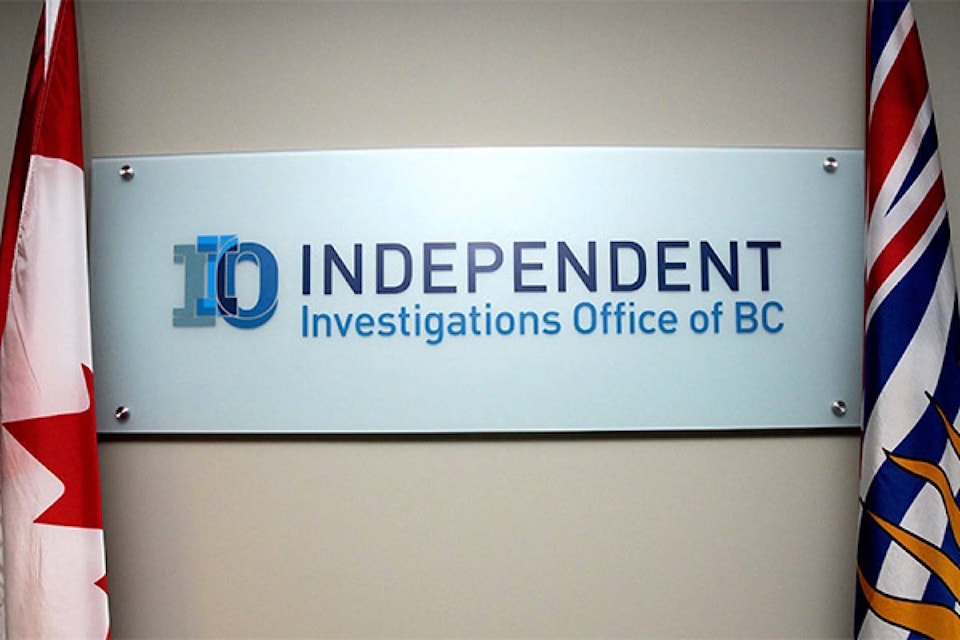B.C.’s police watchdog has found an RCMP officer was justified in the shooting of a man carrying a gun along Highway 5 near Barriere on May 20, 2022, despite little cooperation from the officer and no video footage of the event.
In a decision released Monday, Jan. 8, Ronald J. MacDonald, the Chief Civilian Director of the Independent Investigations Office of B.C. (IIO), said a full account from the subject officer would have “assisted greatly in this investigation,” however, ultimately found the shooting “was more likely than not a justified act of self-defence” after reviewing the evidence.
On the evening of May 20, 2022 two RCMP members responded to a report of a man armed with a rifle on the side of Highway 5 south of Barriere. According to the IIO, the officers encountered the man, and in the interaction that followed, the officer discharged his service pistol, seriously injuring the man.
The IIO was called to investigate the incident, and took statements from the wounded man, 11 other civilian witnesses, four first responders and one witness police officer as well as gathering audio recordings of 911 calls, GPS data from police vehicles, medical evidence, and more.
The officer under investigation by the IIO gave a partial written statement to the IIO through his legal counsel, but did not provide any account of the shooting itself or the motivation for it, said the IIO, noting the IIO does not compel officers who are the subject of an investigation to submit their notes, reports and data.
According to MacDonald’s decision, the man shot by the officer, told IIO investigators he was travelling north on Highway 5 from Kelowna towards Williams Lake as a passenger in a van driven by his common law partner to attend her aunt’s 80th birthday. He said he got out of the vehicle after getting a ‘time out’ from his partner. In another statement he said he got out of the vehicle to shoot a buck he had seen.
His partner, however, told the IIO they were going to visit her sick aunt in hospital when they got into an argument, so she stopped the van and told him to get out.
Shortly afterwards, police received a 911 call about a man dropped off on the side of the road with an ‘assault-style’ rifle, said IIO. The two officers responded, with the one officer further back witnessing the man raise the rifle, ‘rack it’ and point it, then go to the ground in a prone position.
The officer under investigation had shot the man, but the other witnessing officer hadn’t heard the shot, the decision noted. He retrieved the wounded man’s weapon, which was an assault-style .22-calibre rifle, and located an unfired live .22 round on the ground while the officers were providing first aid before paramedics arrived.
“[The subject officer] applied clotting agent to [the man’s] wounds in a life-saving measure, and the officers transported [him] by police vehicle to meet the ambulance, to reduce delay,” noted IIO.
The wounded man later told the IIO that his rifle was pointed at the ground when the officer walked up and shot him “gangster,” … “kinda like a fast draw cowboy.”
The IIO decision noted that medical records show the man suffered one gunshot wound through his left arm and then through his chest from left to right. “The trajectory of the wound in [the man’s] arm is consistent with [him] having his arm raised at the moment of the shooting, as the bullet travelled for a distance along [the man’s] upper arm, through biceps and then triceps before exiting near the armpit,” noted MacDonald in his decision.
MacDonald stated during the investigation an issue arose with recovery of the dash camera video from the officer’s police vehicle. When IIO arrived on scene investigators found the system turned on, but it had a warning that the memory was almost full. When later examined, “the system appeared to contain no recording from the time of the shooting, though a video segment has been recorded subsequently.”
A video analysis expert concluded the system was on at the time of the shooting, but did not record video, and that there was no user input to prevent it from recording.
After reviewing all the evidence, MacDonald concluded there was not reasonable grounds to believe that the officer committed an offence.
READ ALSO: Man dead after police-involved shooting in Abbotsford
